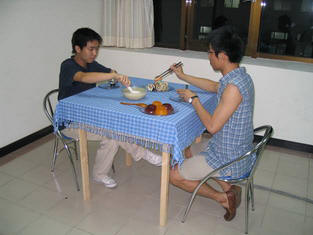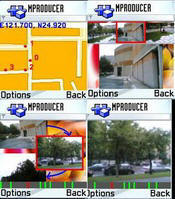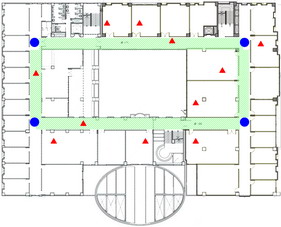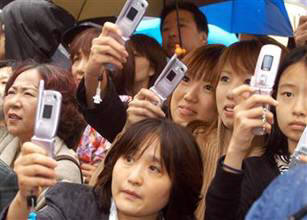|
|
 |
|
|

|
Online Demos
| Baseball Video Analysis |
 Sports video analysis has attracted much attention due to its potential commercial values and entertaining functionalities. Moreover, sports videos often have clear structure or fixed layout. These characteristics facilitate more explicit video analysis so that more practical applications can be developed. Recently, we focus on baseball video analysis and investigate several issues on explicit event detection, automatic game summarization and highlight extraction, and ball trajectory extraction. This webpage shows some demonstrations and provide some sample results about these works.
Sports video analysis has attracted much attention due to its potential commercial values and entertaining functionalities. Moreover, sports videos often have clear structure or fixed layout. These characteristics facilitate more explicit video analysis so that more practical applications can be developed. Recently, we focus on baseball video analysis and investigate several issues on explicit event detection, automatic game summarization and highlight extraction, and ball trajectory extraction. This webpage shows some demonstrations and provide some sample results about these works. |
| |
| Dietary-Aware Dining Table |
 We are what we eat. Research continues to confirm that nutrition profoundly influences many chronic illnesses, and it represents one of the most accessible means for prevention and intervention to reduce health risk and promote well-being. Food choice affects our health in many ways. The vast majority of population has chronic illnesses such as heart disease, diabetes, hypertension, dyslipidemia, and obesity in which proper dietary intake and related interventions have been demonstrated to be effective in ameliorating symptoms and improving health. Unlike traditional health care in which professionals assess and weigh each individual’s dietary intake, and develop a plan for behavior changes, ubiquitous healthcare technologies provide an opportunity for individuals to quantify and acknowledge their dietary intake in the point of living without intensive labor cost. Such technologies provide a mean for individuals to proactively monitor their food intake and act upon it, leading to a better food selection and sensible eating. We are building a dietary-aware dining table that can track what and how much we eat. To enable automated food tracking, the dining table is augmented with two layers of weighting and RFID sensor surfaces to detect and recognize multiple, concurrent person-object interactions occurring on the table.
We are what we eat. Research continues to confirm that nutrition profoundly influences many chronic illnesses, and it represents one of the most accessible means for prevention and intervention to reduce health risk and promote well-being. Food choice affects our health in many ways. The vast majority of population has chronic illnesses such as heart disease, diabetes, hypertension, dyslipidemia, and obesity in which proper dietary intake and related interventions have been demonstrated to be effective in ameliorating symptoms and improving health. Unlike traditional health care in which professionals assess and weigh each individual’s dietary intake, and develop a plan for behavior changes, ubiquitous healthcare technologies provide an opportunity for individuals to quantify and acknowledge their dietary intake in the point of living without intensive labor cost. Such technologies provide a mean for individuals to proactively monitor their food intake and act upon it, leading to a better food selection and sensible eating. We are building a dietary-aware dining table that can track what and how much we eat. To enable automated food tracking, the dining table is augmented with two layers of weighting and RFID sensor surfaces to detect and recognize multiple, concurrent person-object interactions occurring on the table.
video (3.98 MB) |
| |
| Geta Sandals (Indoor Location Systems) |
 This footprint-based indoor location system is built on a pair of traditional Japanese Geta sandals. It can track the indoor position of a user wearing the sandals. It works by measuring and tracking the displacement vectors along a trial of footprints (each displacement vector is formed by drawing a line between each pair of footprints). The position of a user can be calculated by summing up the current and all previous displacement vectors. In comparison to existing indoor location systems, our footprint location system has a unique advantage that it is infrastructure-free. A user simply has to wear the Geta sandals to track his/her locations without any setup or calibration efforts. This makes our footprint method easy for everywhere deployment.
This footprint-based indoor location system is built on a pair of traditional Japanese Geta sandals. It can track the indoor position of a user wearing the sandals. It works by measuring and tracking the displacement vectors along a trial of footprints (each displacement vector is formed by drawing a line between each pair of footprints). The position of a user can be calculated by summing up the current and all previous displacement vectors. In comparison to existing indoor location systems, our footprint location system has a unique advantage that it is infrastructure-free. A user simply has to wear the Geta sandals to track his/her locations without any setup or calibration efforts. This makes our footprint method easy for everywhere deployment.
video (41.22 MB) |
| |
| Personal Experience Computing (mProducer) |
 The mProducer is a mobile authoring tool that enables everyday users to effectively and efficiently perform archiving and editing at or immediately after the point-of-capture of digital personal experiences from their camera-equipped mobile devices. This point-of-capture capability is crucial to enable immediate sharing of digital personal experiences anytime, anywhere. For example, we have seen everyday people who used handheld camcorders to capture and report their personal, eye-witnessed experiences during the September 11 event. With mProducer, they would be able to perform editing immediately after the point of capture, and then share these news-worthy, time-sensitive digital experiences on the Internet. To address the challenges in both user interface constraints and limited system resources on a mobile device, mProducer provides the following innovative system techniques and UI designs: (1) Keyframe-based editing UI enables everyday users to easily and efficiently edit recorded digital experiences from a mobile device using only key frames with the storyboard metaphor(2) Storage constrained uploading (SCU) algorithm archives continuous multimedia data by uploading them to remote storage servers at the point-of-capture, so that it alleviates the problem of limited storage on a mobile device. (3) Sensor-assisted automated editing uses data from a GPS receiver and a tilt sensor attached to a mobile device to facilitate two manual editing steps at the point-of-capture: removal of blurry frames from hand-induced camera shaking, and content search via location-based content management.
The mProducer is a mobile authoring tool that enables everyday users to effectively and efficiently perform archiving and editing at or immediately after the point-of-capture of digital personal experiences from their camera-equipped mobile devices. This point-of-capture capability is crucial to enable immediate sharing of digital personal experiences anytime, anywhere. For example, we have seen everyday people who used handheld camcorders to capture and report their personal, eye-witnessed experiences during the September 11 event. With mProducer, they would be able to perform editing immediately after the point of capture, and then share these news-worthy, time-sensitive digital experiences on the Internet. To address the challenges in both user interface constraints and limited system resources on a mobile device, mProducer provides the following innovative system techniques and UI designs: (1) Keyframe-based editing UI enables everyday users to easily and efficiently edit recorded digital experiences from a mobile device using only key frames with the storyboard metaphor(2) Storage constrained uploading (SCU) algorithm archives continuous multimedia data by uploading them to remote storage servers at the point-of-capture, so that it alleviates the problem of limited storage on a mobile device. (3) Sensor-assisted automated editing uses data from a GPS receiver and a tilt sensor attached to a mobile device to facilitate two manual editing steps at the point-of-capture: removal of blurry frames from hand-induced camera shaking, and content search via location-based content management.
video (32.14 MB) |
| |
| Sensor-Assisted Wi-Fi Indoor Location System |
 Wi-Fi based indoor location systems have been shown to be both cost-effective and accurate, since they can attain meter-level positioning accuracy by using existing Wi-Fi infrastructure in the environment. However, two major technical challenges persist for current Wi-Fi based location systems: instability in positioning accuracy due to changing environment dynamics, and the need for manual offline calibration during site survey. We have looked at three dynamic environment factors (people, doors, and humidity) that can interfere with radio signals and cause positioning inaccuracy in the Wi-Fi location systems are identified. We have proposed a sensor-assisted adaptation method that employs RFID sensors and environment sensors to adapt the location systems automatically to the changing environment dynamics. The adaptation method performs online calibration to build multiple context-aware radio maps under various environment conditions, selects the radio map that best matches the current environment condition, and uses it for to determine the location.
Wi-Fi based indoor location systems have been shown to be both cost-effective and accurate, since they can attain meter-level positioning accuracy by using existing Wi-Fi infrastructure in the environment. However, two major technical challenges persist for current Wi-Fi based location systems: instability in positioning accuracy due to changing environment dynamics, and the need for manual offline calibration during site survey. We have looked at three dynamic environment factors (people, doors, and humidity) that can interfere with radio signals and cause positioning inaccuracy in the Wi-Fi location systems are identified. We have proposed a sensor-assisted adaptation method that employs RFID sensors and environment sensors to adapt the location systems automatically to the changing environment dynamics. The adaptation method performs online calibration to build multiple context-aware radio maps under various environment conditions, selects the radio map that best matches the current environment condition, and uses it for to determine the location. |
| |
| Privacy Cameras |
 Privacy cameras can protect the privacy of passers-by in public spaces given the ubiquity of digital cameras everywhere. Privacy cameras can also protect the camera takers from passers-by who unintentional walk into their pictures and ruin them. Privacy cameras are based on the positioning systems. By knowing the relative locations of passers-by to camera-takers and the cameras' orientations, privacy cameras can determine if passers will enter the recording views of surrounding cameras. In addition, each passer will wear a badge that can warn him/her of recording regions of surrounding cameras. We have incorporated a space model to coordinate the use of spaces and resolve conflicts between camera takers and passers.
Privacy cameras can protect the privacy of passers-by in public spaces given the ubiquity of digital cameras everywhere. Privacy cameras can also protect the camera takers from passers-by who unintentional walk into their pictures and ruin them. Privacy cameras are based on the positioning systems. By knowing the relative locations of passers-by to camera-takers and the cameras' orientations, privacy cameras can determine if passers will enter the recording views of surrounding cameras. In addition, each passer will wear a badge that can warn him/her of recording regions of surrounding cameras. We have incorporated a space model to coordinate the use of spaces and resolve conflicts between camera takers and passers. |
| |
| Social Computing |
|
Everyday, a person can have numerous opportunities to connect with strangers or acquaintances around him/her. We would like to demonstrate how pervasive computing can help a person connect with others by initiating communication, and how (s)he can take advantage of these connections. We envision a future mobile information space (called the MobiSpace) that is constructed based on ad-hoc collaborative networks, where nodes in these networks are capable of broadcasting messages using wireless medium. From a sociological perspective, we investigate relevant theories in the fields of sociology and social psychology. We discuss how these theories can help us formulate new mobile applications for social interaction and collaboration. |
| |
| Ubiquitous Healthcare (iCare & E-Safety) |
|
Motivated to meet the demand and to enhance healthcare quality in the near future, this e-Safety project aims to provide a number of key services for patient safety – (1) pressure sore prevention, (2) emergency alarm, (3) location and activity tracking, and (4) medication compliance and adverse drug reaction (ADR) prevention. For each service to be deployed, this project opts to identify a practical service model and an economical hardware/software system design. The research will involve close collaboration among experts from a variety of disciplines, in particular clinical medicine, health administration, medical informatics, computer science, bio-medical engineering, and electrical engineering, which makes this project not just multidisciplinary but truly interdisciplinary. |
| |
| test |
|
|
| |
|

|

|
|
|
© 2006 CMLaboratory Since 1991. All Rights Reserved.
|
|
&
| |
|
|
|
|
|